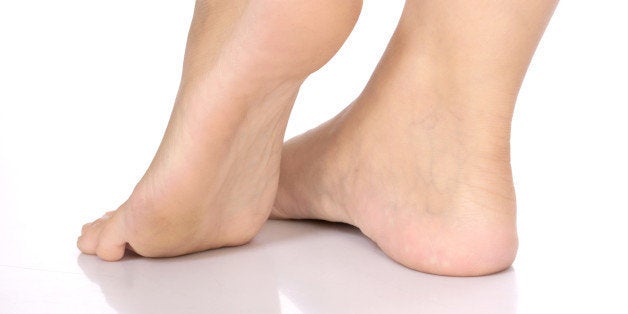
If you are one of the estimated 53 million people who run or jog in America (Outdoor Foundation's Outdoor Participation Report), you may have already heard about plantar fasciitis, a painful condition affecting the heel and one of the most common problems among running enthusiasts. Plantar fasciitis is defined as inflammation of the plantar fascia, the thick tissue on the bottom of the foot that connects the heel bone to the toes and creates the arch of the foot (National Library of Medicine).
While there is a variety of solutions for plantar fasciitis, one of the simplest recommendations is to change shoes because running shoes begin to lose their structural support as the mileage accrues. When that doesn't help, some runners try orthotics or change orthotics to ease their pain. Others seek professional help from primary physicians, orthopedic surgeons, or sports medicine chiropractors who may employ various physical therapy and rehabilitation techniques to solve the problem. Although most of these patients improve, what becomes of the runners who continue to suffer from plantar fasciitis symptoms despite months of rehabilitation and treatment?
First, you have to make sure there isn't a more serious problem with the plantar fascia, such as tearing. Such a condition can typically be visualized through MRI or musculoskeletal ultrasound (MSK US).
Second, running can be demanding on the plantar fascia, Achilles tendon, knee, hip and lumbar spine (low back). Some patients develop pain that follows the path of a nerve from the low back, a condition known as radiculopathy, or spinal nerve root inflammation and injury. Common radiculopathies happen to supply the bottom of the feet and can cause pain in the plantar fascia region.
It is important to realize that not all injuries present in the same manner. I often tell my patients that we don't come off an automobile assembly line. We are not engines that behave the same when they are damaged or repaired. Our bodies are living tissue that can respond or present typically or atypically. This means that some patients can have a problem with a spinal nerve root (radiculopathy), particularly the S1 and L5 nerve roots that produce pain in the thigh, leg and foot, or in some cases, in the foot only. These atypical radiculopathies present with only foot pain that can mimic plantar fasciitis, requiring a second look by your doctor. There are physical exam tests your doctor can perform to check your tendon reflexes, muscle strength in the ankle, knee and hip, and tests to stretch the nerves from your low back to determine if this aggravates your pain.
You may have noticed that certain running stretches -- either common to your routine or instructed by several health care practitioners -- seem to aggravate your symptoms either during the stretch or perhaps a few hours later. This could be a sign of an irritated nerve.
Sometimes, the irritation of a nerve in plantar fasciitis-like cases doesn't come from the lumbar spine. A nerve along the inner (medial) side of the ankle, known as the posterior tibial nerve, can be irritated from overstretching, poor ankle mechanics, or -- in a few cases -- friction from the shoe along the medial ankle. Branches of these nerves can mimic plantar fasciitis when they are irritated. Again, your doctor will have to take a second look, and there are physical exam tests for the posterior tibial neuropathy. One special test for peripheral nerve problems is called a nerve conduction velocity study (NCV). You doctor will determine if this test is required. If results are abnormal, your doctor may then order an MRI or a musculoskeletal ultrasound as imaging tools to determine if there is compression of this nerve.
While most cases of plantar foot pain are actually plantar fasciitis and should respond to treatment accordingly, there is an old expression in health care that still holds true: "If the patient does not improve, the treatment or the diagnosis is wrong." This, of course, applies only to problems that are capable of improvement.
I have seen too many cases of patients who spent many months trying to heal "plantar fasciitis" only to find out the pain was referred from other areas of the body. If your plantar fasciitis is not improving after a fair effort of conservative care, you may need a second look at your presentation.